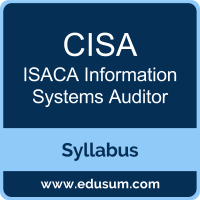 Use this quick start guide to collect all the information about ISACA CISA Certification exam. This study guide provides a list of objectives and resources that will help you prepare for items on the ISACA Information Systems Auditor (CISA) exam. The Sample Questions will help you identify the type and difficulty level of the questions and the Practice Exams will make you familiar with the format and environment of an exam. You should refer this guide carefully before attempting your actual ISACA Certified Information Systems Auditor (CISA) certification exam.
Use this quick start guide to collect all the information about ISACA CISA Certification exam. This study guide provides a list of objectives and resources that will help you prepare for items on the ISACA Information Systems Auditor (CISA) exam. The Sample Questions will help you identify the type and difficulty level of the questions and the Practice Exams will make you familiar with the format and environment of an exam. You should refer this guide carefully before attempting your actual ISACA Certified Information Systems Auditor (CISA) certification exam.
The ISACA CISA certification is mainly targeted to those candidates who want to build their career in IT Audit domain. The ISACA Certified Information Systems Auditor (CISA) exam verifies that the candidate possesses the fundamental knowledge and proven skills in the area of ISACA CISA.
ISACA CISA Exam Summary:
| Exam Name | ISACA Certified Information Systems Auditor (CISA) |
| Exam Code | CISA |
| Exam Price ISACA Member | $575 (USD) |
| Exam Price ISACA Nonmember | $760 (USD) |
| Duration | 240 mins |
| Number of Questions | 150 |
| Passing Score | 450/800 |
| Books / Training |
Conferences In-person training Online training Careers Accredited partner training Customized training |
| Schedule Exam | Exam Registration |
| Sample Questions | ISACA CISA Sample Questions |
| Practice Exam | ISACA CISA Certification Practice Exam |
ISACA CISA Exam Syllabus Topics:
| Topic | Details | Weights |
|---|---|---|
| Information Systems Auditing Process |
- Providing industry-standard audit services to assist organizations in protecting and controlling information systems, Domain-1 affirms your credibility to offer conclusions on the state of an organization’s IS/IT security, risk and control solutions.
A. Planning
B. Execution
|
18% |
| Governance & Management of IT |
- This domain confirms to stakeholders your abilities to identify critical issues and recommend enterprise-specific practices to support and safeguard the governance of information and related technologies.
A. IT Governance
B. IT Management
|
18% |
| Information Systems Acquisition, Development & Implementation |
- Domains 3 and 4 offer proof not only of your competency in IT controls, but also your understanding of how IT relates to business.
A. Information Systems Acquisition and Development
B. Information Systems Implementation
|
12% |
| Information Systems Operations & Business Resilience |
- Domains 3 and 4 offer proof not only of your competency in IT controls, but also your understanding of how IT relates to business.
A. Information Systems Operations
B. Business Resilience
|
26% |
| Protection of Information Assets |
- Cybersecurity now touches virtually every information systems role, and understanding its principles, best practices and pitfalls is a major focus within Domain 5.
A. Information Asset Security and Control
B. Security Event Management
|
26% |
To ensure success in ISACA CISA certification exam, we recommend authorized training course, practice test and hands-on experience to prepare for Information Systems Auditor (CISA) exam.
